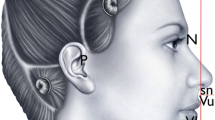Abstract
Background
An increasing number of patients undergo genioplasty for esthetic purposes to correct micrognathism or retrognathism. However, these conditions are considered an important risk factor for snoring. The purpose of this study was to evaluate both esthetic improvement and functional changes of snoring symptoms in patients who underwent hat-shaped mortised advancing genioplasty with genioglossus muscle advancement.
Materials and Methods
This retrospective study enrolled 25 patients. We evaluated scores for subjective snoring classification (Stanford scale) and questionnaire findings for esthetic results.
Results
Most people (96%) were satisfied with the esthetic improvement after surgery. The grade of subjective snoring classification (Stanford scale) improved from 8.68 (range 0–10) to 4.08 (range 0–10) after surgery. Twenty-four patients had an improved snoring grade. All patients reported a positive impact on their daily activity and self-confidence, and they were willing to recommend the same operation to someone with the same clinical problems.
Conclusion
We conclude that hat-shaped mortised advancing genioplasty with genioglossus muscle advancement can relieve the symptoms of snoring for patients with hypoplastic chin or retrogenia. Patients were satisfied with the functional and esthetic results.
Level of Evidence IV
This journal requires that authors assign a level of evidence to each article. For a full description of these Evidence-Based Medicine ratings, please refer to the Table of Contents or the online Instructions to Authors www.springer.com/00266.




Similar content being viewed by others
References
Nelson S, Hans M (1997) Contribution of craniofacial risk factors in increasing apneic activity among obese and nonobese habitual snorers. Chest 111(1):154–162
Bacon WH, Turlot JC, Krieger J, Stierle JL (1990) Cephalometric evaluation of pharyngeal obstructive factors in patients with sleep apneas syndrome. Angle Orthod 60(2):115–122
Mezzanotte WS, Tangel DJ, White DP (1996) Influence of sleep onset on upper-airway muscle activity in apnea patients versus normal controls. Am J Respir Crit Care Med 153(6 Pt 1):1880–1887
Kobayashi I, Perry A, Rhymer J, Wuyam B, Hughes P, Murphy K, Innes JA, McIvor J, Cheesman AD, Guz A (1996) Inspiratory coactivation of the genioglossus enlarges retroglossal space in laryngectomized humans. J Appl Physiol 80(5):1595–1604
Mezzanotte WS, Tangel DJ, White DP (1992) Waking genioglossal electromyogram in sleep apnea patients versus normal controls (a neuromuscular compensatory mechanism). J Clin Invest 89(5):1571–1579
Rojas R, Chateau R, Gaete C, Munoz C (2018) Genioglossus muscle advancement and simultaneous sliding genioplasty in the management of sleep apnoea. Int J Oral Maxillofac Surg 47(5):638–641
Yin SK, Yi HL, Lu WY, Guan J, Wu HM, Cao ZY, Yu DZ, Huang YY, Wu CG (2007) Anatomic and spiral computed tomographic study of the genial tubercles for genioglossus advancement. Otolaryngol Head Neck Surg 136(4):632–637
Thuler ER, Dibbern RS, Fomim DS, Oliveira JAA (2002) Uvulopalatoplastia a laser: Análise comparativa da melhora clínica e dos critérios de indicação. Rev Bras Otorrinolaringol 68(2):190–193
Rodrigues MM, Dibbern RS, Goulart CWK (2010) Correlation between subjective classification of snoring and the apnea–hypopnea index. Sleep Sci 3(3):103–106
Choi BK, Goh RC, Moaveni Z, Lo LJ (2010) Patient satisfaction after zygoma and mandible reduction surgery: an outcome assessment. J Plast Reconstr Aesthet Surg 63(8):1260–1264
Hendler BH, Costello BJ, Silverstein K, Yen D, Goldberg A (2001) A protocol for uvulopalatopharyngoplasty, mortised genioplasty, and maxillomandibular advancement in patients with obstructive sleep apnea: an analysis of 40 cases. J Oral Maxillofac Surg 59(8):892–897 (discussion 898–899)
Zhang C, Zhao L, Li CR, Shim YH, Cao D (2017) Advancing and lengthening genioplasty in contouring of the receding and short chin. J Craniofac Surg 28(2):314–317
Kang M (2014) Incidence of complications associated with mandibuloplasty: a review of 588 cases over 5 years. Plast Reconstr Surg Glob Open 2(4):e139
Hoenig JF (2007) Sliding osteotomy genioplasty for facial aesthetic balance: 10 years of experience. Aesthetic Plast Surg 31(4):384–391
Hofer O (1942) Operation der Prognathie und Mikrogenie. Dtsch Zahn Mund Kieferheilkd 9:121–132
Trauner R, Obwegeser H (1957) The surgical correction of mandibular prognathism and retrognathia with consideration of genioplasty. II. Operating methods for microgenia and distoclusion. Oral Surg Oral Med Oral Pathol 10(8):787–792
Nadjmi N, Van Roy S, Van de Casteele E (2017) Minimally invasive genioplasty procedure. Plast Reconstr Surg Glob Open 5(11):e1575
Rodrigues MM, Dibbern RS, Goulart CW, Palma RA (2010) Correlation between the Friedman classification and the apnea–hypopnea index in a population with OSAHS. Braz J Otorhinolaryngol 76(5):557–560
Remmers JE, deGroot WJ, Sauerland EK, Anch AM (1978) Pathogenesis of upper airway occlusion during sleep. J Appl Physiol Respir Environ Exerc Physiol 44(6):931–938
van Lunteren E (1993) Muscles of the pharynx: structural and contractile properties. Ear Nose Throat J 72(1):27–29
Silverstein K, Costello BJ, Giannakpoulos H, Hendler B (2000) Genioglossus muscle attachments: an anatomic analysis and the implications for genioglossus advancement. Oral Surg Oral Med Oral Pathol Oral Radiol Endod 90(6):686–688
Goh YH, Tan W, Abdullah VJ, Kim SW (2017) Advances in box surgery for obstructive sleep apnea: genioglossus advancement, hyoid suspension, and maxillomandibular advancement. Adv Otorhinolaryngol 80:99–108
Garcia Vega JR, de la Plata MM, Galindo N, Navarro M, Diez D, Lancara F (2014) Genioglossus muscle advancement: a modification of the conventional technique. J Craniomaxillofac Surg 42(3):239–244
Santos Junior JF, Abrahao M, Gregorio LC, Zonato AI, Gumieiro EH (2007) Genioplasty for genioglossus muscle advancement in patients with obstructive sleep apnea–hypopnea syndrome and mandibular retrognathia. Braz J Otorhinolaryngol 73(4):480–486
Author information
Authors and Affiliations
Corresponding author
Ethics declarations
Conflict of interest
The authors have no potential conflicts of interest with respect to the research, authorship, and publication of this article to declare.
Ethical Approval
All procedures performed in studies involving human participants were in accordance with the ethical standards of the institutional and/or national research committee and with the 1964 Helsinki declaration and its later amendments or comparable ethical standards.
Rights and permissions
About this article
Cite this article
Choi, B.K., Yun, I.S., Kim, Y.S. et al. Effects of Hat-Shaped Mortised Genioplasty with Genioglossus Muscle Advancement on Retrogenia and Snoring: Assessment of Esthetic, Functional, and Psychosocial Results. Aesth Plast Surg 43, 412–419 (2019). https://doi.org/10.1007/s00266-018-1290-z
Received:
Accepted:
Published:
Issue Date:
DOI: https://doi.org/10.1007/s00266-018-1290-z




